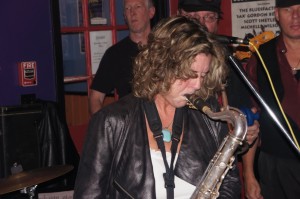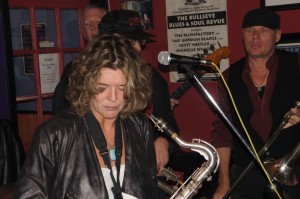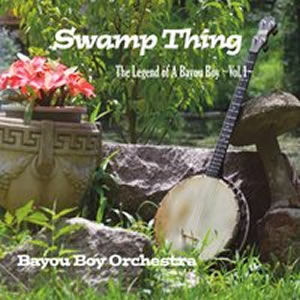 Rosemary’s Baby Blues is a cool horn band serving up cool blues and hot funk. They rocked Smoken’ Joe’s in Boston last Saturday night. Led by the foxy, wiry Rosemary Casey on saxophone, the three horns, guitarist, and rhythm section each held up their corner of the wavy, wiry sounds that filled the room. There was always a sense of movement in their music. These players kept several melody instruments playing simultaneously and the very palpable rhythmic pulse from the bass and drums rocked the room. Local legend Barrence Whitfield was in the crowd, and he took to the microphone a few times to liven things up.
Rosemary’s Baby Blues is a cool horn band serving up cool blues and hot funk. They rocked Smoken’ Joe’s in Boston last Saturday night. Led by the foxy, wiry Rosemary Casey on saxophone, the three horns, guitarist, and rhythm section each held up their corner of the wavy, wiry sounds that filled the room. There was always a sense of movement in their music. These players kept several melody instruments playing simultaneously and the very palpable rhythmic pulse from the bass and drums rocked the room. Local legend Barrence Whitfield was in the crowd, and he took to the microphone a few times to liven things up.
Rosemary’s Baby Blues opened with “Last Night.” Casey’s sax line dipped, bopped, and took all sorts of twists and turns. Trumpet player John Abrahamsen blasted his way in with his wide, fulsome scream. Trombonist Lennie Peterson came in last with the thickest take on the vibrant melody line. The rhythm section had it in the pocket, creating movement and feeling and groove from the get go. Guitarist Peter Henderson came in with an incisive phrase that cut through the layers of sound. Guest drummer Chip Fontaine filled in for the vacationing Larry Bassick.
The band featured guitarist-vocalist Peter Henderson on lead vocals. His smooth, light vocal approach on “Goodtime Charlie” lead to an opening for trumpeter John Abrahamsen to blow a jubilant melody that made hefty waves of attitude. Bass player Mike Walker had the talent to hold all of this up while remaining distinct in the mix, keeping a nice twangy low end going on.
Abrahamsen did an old timey trumpet phrase in unison with Peterson’s trombone line during “Flip Flop and Fly.” The effect was impressive, showing the crowd that two horns could play the twists and turns together. Hendersen’s lead guitar notes rang out with authenticity on “Lonely Nights” while the three piece horn section kept a zesty, grooving wave behind him. Henderson continued his guitar tastefulness on “What’s Good For You Is Good For Me Too.”
One of the coolest songs Rosemary’s Baby Blues performed was “Nickels And Dimes.” A palpable bass line was smoking hot under all the wavy horn sounds. The three horns were fantastic playing one at a time. Together, they built huge arcing forces that moved forward with purpose and ease. “Caledonia” was marked by trombone shots that punched up the melody with iaction packed feistiness. Henderson told a humorous story about Caledonia, a woman he gave his credit card to and told to be home by midnight.
“Looking For Trouble” played out with a surf-like rhythmic pulse. The speedy guitar and rhythm section got a run for their money from the racing horn melodies. The whole effect was it make you want to move your feet to their oldies beat. “Hootchie Cootchie Man” began as a steady slow marching stomp. The slow boiling horn section cooked one helluva tasty broth. Layers of sax(thick), trumpet(thicker), and trombone(thickest) made for one hefty dose of horn. Guitar man Henderson swirled some notes around and used dynamics to create a huge emotive melodic phase.
 Magic Slim’s “You Were Wrong” came off as a bluesy, danceable fun number with Henderson finessing the lyrics and the horn section oozing out slabs of rhythmic house rocking blues. Abrahamsen went to town with a loud greasy phrase that introduced a racing, rocking phrase from Casey.
Magic Slim’s “You Were Wrong” came off as a bluesy, danceable fun number with Henderson finessing the lyrics and the horn section oozing out slabs of rhythmic house rocking blues. Abrahamsen went to town with a loud greasy phrase that introduced a racing, rocking phrase from Casey.
Henderson got an organ tone effect going on “Wang Dang Doodle,” a hefty grooving blues shuffle. Drummer Chip Fontaine helped the bass keep that extra thick crust in the rhythm section, holding up all of the guitar and horn magic on top.
Enter Barrence Whitfield. The Boston music scene vocalist made an exciting guest appearance, showing why he’s so well-respected. His voice is full of range, dynamics, richness, color and tone, and he called up whichever he needed when he needed it. Whitfield added his own special richness on “Shake, Rattle, And Roll.” Howlin’ Wolf’s “Killing Floor” gave the Whitfield another chance to strut more of his stuff. His deep, rich vocal created the color for this blues standard. Guitar and horns followed his feeling and found themselves riding merrily along. Casey and Abrahamsen paraded their melody lines around the room, stopping at individual tables to give a close up samples of their brassy exuberance.
Rosemary’s Baby Blues got much funkier in their second set. “Pass The Peas” found Casey playing a hip, sultry sax line the had more boogie than her first set stuff. Abrahamsen came in with a sharp, refined trumpet line that darted around the groove like madness. Chip Fontaine’s all too brief drum solo got plenty of feeling out of each piece, especially his toms. Henderson came screaming in with high notes that sounded like they were on fire running down the street to find some water to jump into.
“Good Times Roll” came off more like oldies rock and roll than blues, with the horns sounding a little bit Memphis. Henderson’s vocal flow gave the song its party locomotion. Casey, especially, rocked it here. Her coolest interjection was a slippery sax line that moved around the groove like it had an eccentric mind of its own. Casey must be an A.D.D. saxophonist because she can suddenly stop one cool line and begin something entirely different.
A perfect speedy drumbeat kept “Got My Mojo Workin’” at a breakneck pace. Casey, meanwhile, blew a nervous, twitching sax line that zig zagged around the tempo. “Walkin’ The Dog” got its hefty dose of funk from the rhythm section. The melodic instruments peppered it with plenty of spices, turning it into a multi-dimensional rendition.
 “Every Dog Has His Day” was marked by Peterson’s hearty, sharp, clean trombone shots. Soon, Whitfield came back up to do some more soulful vocal work. He reached deep down inside of himself to bring up a gem of a pain song, and his song, in a way, showed how a song can ease pain. Whitfield likes to tell wild stories of romance gone bad. The narration he told about a woman who took his ring only to catch her flopping around with his friend Tom was a classic.
“Every Dog Has His Day” was marked by Peterson’s hearty, sharp, clean trombone shots. Soon, Whitfield came back up to do some more soulful vocal work. He reached deep down inside of himself to bring up a gem of a pain song, and his song, in a way, showed how a song can ease pain. Whitfield likes to tell wild stories of romance gone bad. The narration he told about a woman who took his ring only to catch her flopping around with his friend Tom was a classic.
Rosemary’s Baby Blues closed out with the trumpet work of Abrahamsen traipsing through a breezy flow of notes and mellifluously dovetailing with Peterson’s trombone lines.
Rosemary’s Baby Blues certainly kept the party vibe going on all evening. RBB keep waves of horn melody flowing over irresistible, palpable grooves with guitar lines zig zagging around for extra spark. They play each song like a bartender gives a drink extra kick. By pouring in a bunch of good stuff.

